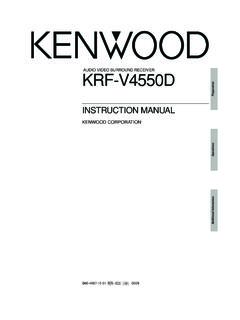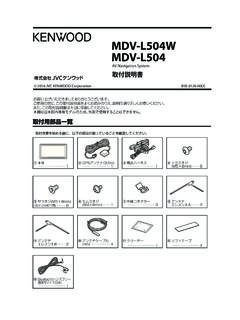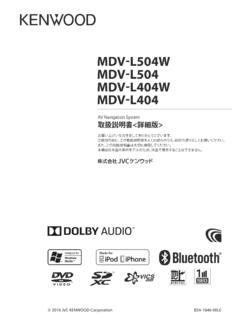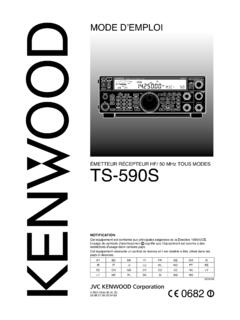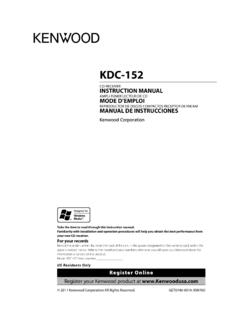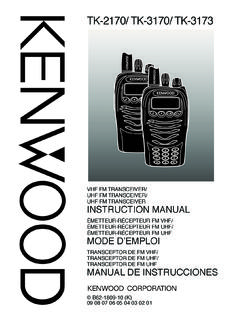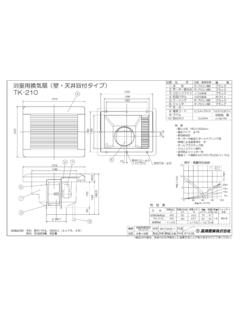Transcription of TK-5210 TK-5310 TK-5410 - KENWOOD
1 INSTRUCTION MANUAL. VHF P25 TRANSCEIVER. TK-5210 . UHF P25 TRANSCEIVER. TK-5310 . 700/800 MHz P25 TRANSCEIVER. TK-5410 . B62-2155-00 (K, K2, K3, K4, K5, K6, K7). 09 08 07 06 05 04 03 02 01 00. Terminal Descriptions Universal connector It is possible to use a resin-based cover for the Universal connector. No. Name Description Specification I/O. 1 SSW Ext/Int Speaker Switch Input Hi: INT, Low: EXT I. 2 SP+ BTL Output + for External Speaker Standard load 8 O. 3 SP- BTL Output for External Speaker Standard load 8 O. 4 MSW Ext/Int MIC Switch Input Hi: INT, Low: EXT I. 5 EMC External MIC Input Impedance: k I. 6 ME External MIC GND . 7 PTT External PTT Input Low: PTT ON I. 8 PF Programable Function Key Input Input voltage: 0 V - V I.
2 I: 0 V - V 9 OPT Aux I/O Port (for EXT Option) I/O. O: Standard load 25 k . 10 E GND GND . 5V power supply output 11 5V 5V O. Max output current: 140 mA. 12 TXD Serial Data Output Baud rate: 115200 bps max O. 13 RXD Serial Data Input Baud rate: 115200 bps max I. 14 NC Not used . Antenna Terminal 50 impedance Thank You We are grateful you have chosen KENWOOD for your land mobile radio applications. Models Covered by this Manual The models listed below are covered by this manual: TK-5210 (K/K2/K3/K7): VHF P25 Transceiver TK-5310 (K/K2/K3/K4/K5/K6/K7): UHF P25 Transceiver TK-5410 (K2/K3): 700/800 MHz P25 Transceiver Notices to the User Government law prohibits the operation of unlicensed radio transmitters within the territories under government control.
3 Illegal operation is punishable by fine and/or imprisonment. Refer service to qualified technicians only. SAFETY: It is important that the operator is aware of and understands hazards common to the operation of any transceiver. Firmware Copyrights The title to and ownership of copyrights for firmware embedded in KENWOOD product memories are reserved for KENWOOD Corporation.. This device made under license under one or more of the following US Patents: 4,590,473; 4,636,791; 4,716,407; 4,972,460; 5,148,482;. 5,185,796; 5,271,017; 5,377,229; 5,502,767. The IMBE voice coding Technology embodied in this product is protected by intellectual property rights including patent rights, copyrights, and trade secrets of Digital Voice Systems, Inc.
4 This voice coding Technology is licensed solely for use within this Communications Equipment. The user of this Technology is explicitly prohibited from attempting to decompile, reverse engineer, or disassemble the Object Code, or in any other way convert the Object Code into a human- readable form. The AMBE+2 voice coding Technology embodied in this product is protected by intellectual property rights including patent rights, copyrights and trade secrets of Digital Voice Systems, Inc. This voice coding Technology is licensed solely for use within this Communications Equipment. The user of this Technology is explicitly prohibited from attempting to extract, remove, decompile, reverse engineer, or disassemble the Object Code, or in any other way convert the Object Code into a human-readable form.
5 Patent Nos. #5,870,405, #5,826,222, #5,754,974, #5,701,390, #5,715,365, #5,649,050, #5,630,011, #5,581,656, #5,517,511, #5,491,772, #5,247,579, #5,226,084 and #5,195,166. ii One or more of the following statements may be applicable: FCC WARNING. This equipment generates or uses radio frequency energy. Changes or modifications to this equipment may cause harmful interference unless the modifications are expressly approved in the instruction manual. The user could lose the authority to operate this equipment if an unauthorized change or modification is made. INFORMATION TO THE DIGITAL DEVICE USER REQUIRED BY. THE FCC. This equipment has been tested and found to comply with the limits for a Class B digital device, pursuant to Part 15 of the FCC Rules.
6 These limits are designed to provide reasonable protection against harmful interference in a residential installation. This equipment generates, uses and can generate radio frequency energy and, if not installed and used in accordance with the instructions, may cause harmful interference to radio communications. However, there is no guarantee that the interference will not occur in a particular installation. If this equipment does cause harmful interference to radio or television reception, which can be determined by turning the equipment off and on, the user is encouraged to try to correct the interference by one or more of the following measures: Reorient or relocate the receiving antenna. Increase the separation between the equipment and receiver.
7 Connect the equipment to an outlet on a circuit different from that to which the receiver is connected. Consult the dealer for technical assistance. iii The RBRC Recycle seal found on KENWOOD nickel-cadmium (Ni-Cd) battery packs indicates KENWOOD 's voluntary participation in an industry program to collect and recycle Ni-Cd batteries after their operating life has expired. The RBRC. program is an alternative to disposing Ni-Cd batteries with your regular refuse or in municipal waste streams, which is illegal in some areas. For information on Ni-Cd battery recycling in your area, call (toll free) 1-800-8-BATTERY (1-800-822-8837). KENWOOD 's involvement in this program is part of our commitment to preserve our environment and conserve our natural resources.
8 The RBRC Recycle seal found on KENWOOD nickel metal hydride (Ni-MH) battery packs indicates KENWOOD 's voluntary participation in an industry program to collect and recycle Ni-MH batteries after their operating life has expired. The RBRC. program is an alternative to disposing Ni-MH. batteries with your regular refuse or in municipal waste streams, which is illegal in some areas. For information on Ni-MH battery recycling in your area, call (toll free) 1-800-8-BATTERY (1-800-822-8837). KENWOOD 's involvement in this program is part of our commitment to preserve our environment and conserve our natural resources. The RBRC Recycle seal found on KENWOOD lithium-ion (Li-ion) battery packs indicates KENWOOD 's voluntary participation in an industry program to collect and recycle Li-ion batteries after their operating life has expired.
9 The RBRC. program is an alternative to disposing Li-ion batteries with your regular refuse or in municipal waste streams, which is illegal in some areas. For information on Li-ion battery recycling in your area, call (toll free) 1-800-8-BATTERY (1-800-822-8837). KENWOOD 's involvement in this program is part of our commitment to preserve our environment and conserve our natural resources. iv Precautions Do not charge the transceiver and battery pack when they are wet. Ensure that there are no metallic items located between the transceiver and the battery pack. Do not use options not specified by KENWOOD . If the die-cast chassis or other transceiver part is damaged, do not touch the damaged parts. If a headset or headphone is connected to the transceiver, reduce the transceiver volume.
10 Pay attention to the volume level when turning the squelch off. Do not place the microphone cable around your neck while near machinery that may catch the cable. Do not place the transceiver on unstable surfaces. Ensure that the end of the antenna does not touch your eyes. When the transceiver is used for transmission for many hours, the radiator and chassis will become hot. Do not touch these locations when replacing the battery pack. Do not immerse the transceiver in water. When water gets into the microphone opening or the speaker grill, the voice level may become incoherent or distorted. Lightly shake the transceiver to remove the water from the speaker and/or microphone before operating the transceiver. Always switch the transceiver power off before installing optional accessories.
